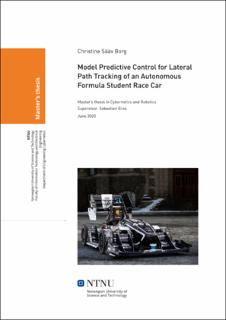| dc.contributor.advisor | Gros, Sebastien | |
| dc.contributor.author | Borg, Christine Sääv | |
| dc.date.accessioned | 2021-09-23T18:10:09Z | |
| dc.date.available | 2021-09-23T18:10:09Z | |
| dc.date.issued | 2020 | |
| dc.identifier | no.ntnu:inspera:56990118:18377918 | |
| dc.identifier.uri | https://hdl.handle.net/11250/2780940 | |
| dc.description.abstract | I flere tiår har Formula Student vært en velletablert ingeniørkonkurranse for studenter over hele verden. Konkurransen har i hovedsak vært arrangert for å teste studentenes kunnskap og evner innenfor det mekaniske og elektriske fagfeltet. Som et resultat av den teknologiske utviklingen i verden, valgte Formula Student å holde sin første konkurranse for autonome racer biler sommeren 2018, noe som åpnet opp mulighetene for et helt nytt ingeniørfelt. Alt fra avanserte oppfatningssytemer til komplekse reguleringssystemer blir nå tested i ekstreme forhold. En av oppgavene til reguleringssystemet er å bestemme optimal styrevinkel basert på racerbanen, og samtidig unngå ustabil oppførsel, noe som ikke er trivielt for de gitte omstendighetene.
I denne oppgaven har et slikt lateralt reguleringssystem blitt utviklet og implementert for den førerløse bilen til Formula Student laget Revolve NTNU. I fordypningsprosjektet som er relatert til denne oppgaven, ble det utført en analyse som konkluderte med at modellprediktiv regulering (MPC) vil gi best resulat basert på ønsket oppførsel, i tillegg til utviklingsstadiet til den førerløse bilen i dag. MPC er en optimal regulator som predikerer bilens oppførsel, og basert på dette kan gi den optimale styrevinkelen til racer bilen. To modeller er forseslått for å predikere bilens oppførsel, en kinematisk og en dynamisk. Den kinematiske modellen tar kun hensyn til bilens posisjon og hastighet, mens den dynamiske også inkluderer krefter og momenter.
De resulterende MPC implementasjonene har vist varierende resultater gjennom de tre eksperimentene, rett bane, sirkel med konstant radius og en Formula Student inspirert bane. MPC implementasjonen som bruker den kinematiske bilmodellen viser stabile resultater for alle testene, mens MPC implementasjonen som bruker den dynamiske bilmodellen viser vanskeligheter når det kommer til å følge de gitte kurvaturene. Eksperimentene har i tillegg vist svakheter ved den implementerte simulatoren, ved at den autonome racer bilen kan gjennomføre svinger med urealistiske høye hastigheter. | |
| dc.description.abstract | For decades, Formula Student has been a well-established engineering competition for students all over the world. The engineering competition was first introduced for students within the mechanical and electrical fields. However, in 2018 Formula Student held their first competition for driverless race cars. The autonomous competition opens for several new fields, from advanced perception systems to complex control systems. Within the field control systems, an important task is to track the desired path in the lateral direction. Deciding the optimal wheel angle, while avoiding unstable behavior may not be trivial, especially during the velocities and accuracy a race car aims for.
In this thesis, a lateral control system has been developed and implemented for the autonomous race car developed by the Formula Student team, Revolve NTNU. In the specialization topic associated with this thesis, an analysis was conducted which concluded that Model Predictive Control (MPC) will give the best results based on the desired behavior and the current stage of the development of the driverless vehicle. The MPC method is an optimal controller that will give the desired steering angle based on the predicted behavior of the vehicle. Two models are proposed for predicting vehicle behavior, a kinematic model, and a dynamic model. The kinematic model only takes into account the vehicle positions and velocities, whilst the dynamic model includes the forces and moments generated by the vehicle actions.
The resulting MPC implementations have shown results of varying levels through the three experiments, straight-line driving, constant radius circle, and the Formula Student inspired track. The MPC implementation using the kinematic vehicle model shows stable results for all given experiments, while the implementation using the dynamic vehicle model has difficulties when it comes to tracking the given curvatures. Additionally, the experiments have shown shortcomings when it comes to the implemented simulator. Using the MPC implementation that uses the kinematic vehicle model, the autonomous race car manages to do small radius cornering at unrealistic high velocities. | |
| dc.language | | |
| dc.publisher | NTNU | |
| dc.title | Model Predictive Control for Lateral Path Tracking of an Autonomous Formula Student Race Car | |
| dc.type | Master thesis | |
